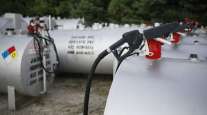Diesel, Gasoline Decline, Breaking String of Increases
This story appears in the March. 11 print edition of Transport Topics.
The string of fevered increases in U.S. retail diesel and gasoline prices broke last week as the Department of Energy reported declines for both of the products.
DOE’s Energy Information Administration said March 4 that diesel fell by 2.9 cents a gallon to an average of $4.13. Prior to that, trucking’s main fuel shot up by 26.5 cents a gallon — after six straight increases — to the highest level in more than 4½ years. The average pump price was $4.094 at the corresponding time in 2012.
At the same time, gasoline dipped by 2.5 cents a gallon to $3.759, EIA said, ending a 10-week streak of increases that added 53 cents a gallon to its average cost. Although the spree added 16.3% to the price of a gallon in just 2½ months, it still did not push the average to a 12-month high. A year ago, the gas average stood at $3.793.
The dip in retail diesel and gas prices follows a month of declines in futures contracts for crude oil in New York and London.
A fleet executive said that while a long-term price decline would be welcome, even a standstill offers some benefits.
“The biggest issue with rising fuel prices is cash flow and floating the cost of that big spike,” said Gabe Stephens, vice president of C.C. Jones Trucking in North Little Rock, Ark. Stephens said his family’s 60-year-old refrigerated carrier usually pays fuel vendors three times per week, whereas it can take about 30 days to receive payment for transportation services.
Therefore, when diesel prices hover rather than soar, a carrier’s fuel surcharge can catch up, Stephens said.
A report from EIA said that while highway transportation consumes most of the nation’s distillate, competing uses have declined somewhat.
“Domestic use of distillate fuels fell in 2012 despite steady demand from on-highway transportation, by far the largest user. The decline in domestic consumption of 156,000 barrels per day, or 4% compared with 2011, broke a trend that saw distillate use rise by 4.7% in 2010 and 2.6% in 2011 as the economy recovered,” the EIA report said.
Although domestic uses of distillate are down, exports remain strong, which should keep prices from falling significantly, the report said.
Bob Costello, American Trucking Associations’ chief economist, said recently that in 2012, diesel consumption by trucking was about 37.9 billion gallons, and motor carrier usage of gasoline was about 14.9 billion gallons.
The national diesel average has been at or above $4 a gallon for 30 of the past 53 weeks, leading carrier managements to work hard at finding ways to scrape together savings.
Refrigerated fleet C.R. England Inc. said March 4 that it will install wheel covers made by A de F Ltd. of St. Paul, Minn. Moving beyond tractor and trailer fairings, which are frequently seen, the covers smooth out the interface between wheel ends and highway air, thereby reducing aerodynamic drag, with the aim of improving fuel economy.
Mennel Milling Co. is not expanding its fleet of tractors, but it is updating its complement of 65 trucks, said Gary Strausbaugh, its vice president of transportation.
“We’re replacing older equipment with newer and better trucks that are more efficient,” said Strausbaugh, who also is chairman of the National Private Truck Council. Strausbaugh said he is specifying automated manual transmissions because of their fuel-saving properties, adding that private fleets often are using more route optimization software to help mitigate fuel spending.
At the Truckload Carriers Association annual meeting, Brad Simons, president of the Pathway Network, spoke to carrier managers on the exhibit floor.
“Everyone wants to know what the market will do,” said Simons, whose Oklahoma City-based company provides fuel services to fleets and truck stops. Simons said he thinks fuel prices are more likely to go down now rather than up.
“Even though the supply of distillate is below the five-year average, demand is not very strong, especially since we didn’t have a very cold winter,” Simons said, referring to diesel and home heating oil, both of which are distillate fuels.
In the market for crude oil futures contracts, Nymex crude shed $7.82 a barrel from Jan. 30 to March 4, dropping to $90.12 from $97.94 a barrel. It closed at $91.56 on March 7.
In London, Brent crude futures have also declined from Feb. 8 to March 4, losing $8.81 a barrel to $110.09, before closing at $111.15 on March 7.




